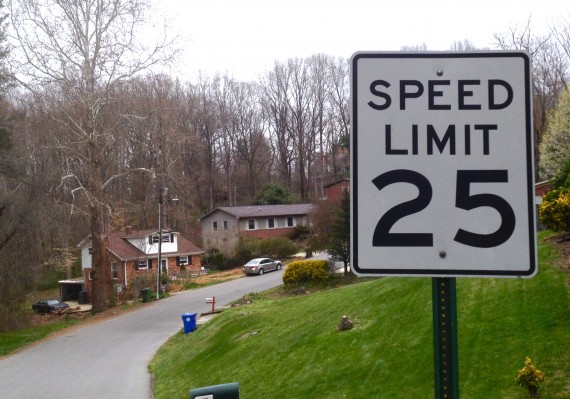Like many streets in Asheville, Macon Avenue has a speeding problem. The corridor through the Grove Park – Sunset Mountain Neighborhood sees some 7,000 vehicles from a combination of residential, cut-through and tourist traffic each day. Unfortunately, many of these drivers exceed the speed limit through the residential area, a dangerous practice magnified the presence of by joggers, walkers and bicyclists. The same goes for nearby Charlotte Street, Kimberly Avenue and Edwin Place. Now, a coalition of neighbors, police and city engineers are banding together to seek solutions.
“Our neighborhood has been discussing the issue for a number of years,” says Alan Escovitz. “It got us thinking about what we could do to make a difference.” Escovitz, who sits on the city’s Neighborhood Advisory Committee, says the resulting partnership is making headway in exploring multi-pronged solutions to reduce speeding in the neighborhood, strategies that could eventually expand to other parts of Asheville.
“We are fortunate to have members of neighborhoods that are willing to help develop solutions,” said Traffic Engineer Jeff Moore. “Throughout the city, the public really wants to be involved in addressing speed issues. It is a collaborative approach.”
Asheville’s city-wide speed limit is 35 miles an hour, but many of the city’s streets are marked for 25 or even 20 mph. Violating those speed limits makes corridors less safe for pedestrians, bicyclists and other drivers.
“This is a problem all over the city,” Escovitz says. “It got us thinking what we could do to make a difference.”
Discussions center on three fronts of education, engineering and enforcement, and the city’s Transportation Department and Police Department have been engaging with neighbors to advance ideas for positive solutions.
“All of us are bringing information from our own expertise to make sure we have a well-rounded effort,” says Community Resource Officer Todd Brigman. Using data from road traffic tests, the APD will be able to target specific times and trouble spots, as well as offer a visible deterrent to speeding. The Transportation Department, through the Road Safety Review Team, can also offer reengineering of crosswalks and intersections or traffic calming devices.
But not all areas are appropriate for traffic calming measures, and the APD cannot be everywhere at once, so strategies like education and awareness efforts need to come into play. And that’s how neighbors can make an impact.
“We need to change the way people think about speeding,” Moore says. “The problem is that many people don’t think about what speed they are driving, and just drive at whatever speed they are comfortable. And that’s a problem in neighborhoods where people are walking and playing.”
Ideas for education outreach include yard signs, neighborhood outreach and a neighborhood speed accountability program where neighbors sign pledges to comply with the speed limit. A sticker campaign could further spread the word.
“If more people drive slower, it conveys a message that ‘our neighborhood drives the speed limit,’” Moore said. “It lets people know that speeding is not OK.”
By connecting driving habits to community and neighborhood ownership and pride, the group hopes neighbors will drive more conscientiously.
“People want to feel safe and secure in their neighborhoods whether they are driving, walking, bicycling, or their kids are playing,” Escovitz says. “”We can’t do it alone, the APD can’t do it alone and the Transportation office can’t do it alone.”
Watch for more details on this exciting neighborhood initiative as more details on speed reduction and education program roll out.
